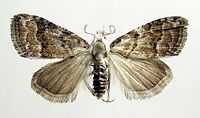Nola aerugula
From Wikipedia, the free encyclopedia
| Nola aerugula | |
|---|---|
 | |
| Scientific classification | |
| Kingdom: | Animalia |
| Phylum: | Arthropoda |
| Class: | Insecta |
| Order: | Lepidoptera |
| Family: | Nolidae |
| Genus: | Nola |
| Species: | N. aerugula |
| Binomial name | |
| Nola aerugula (Hübner, 1793) | |
| Synonyms | |
| |
The Scarce Black Arches (Nola aerugula) is a moth of the Nolidae family. It is found in most of Europe, east to eastern Asia and Japan. It is a rare migrant to Great Britain.
The wingspan is 15–20 mm. Adults are on wing from June to August in one generation.
The larvae mainly feed on Trifolium and Lotus corniculatus, but also Betula, Salix and Populus species. The larvae of ssp. holsatica feed on Genista anglica and Genista pilosa. Larvae can be found from August to June. They overwinter. Pupation takes place in a cocoon which can be found on the ground or attached to the host plant just above the ground.
Subspecies
- Nola aerugula aerugula
- Nola aerugula holsatica Sauber, 1916 (Denmark, the Netherlands)
Many authors consider holsatica to be a full species.
External links
This article is issued from Wikipedia. The text is available under the Creative Commons Attribution/Share Alike; additional terms may apply for the media files.